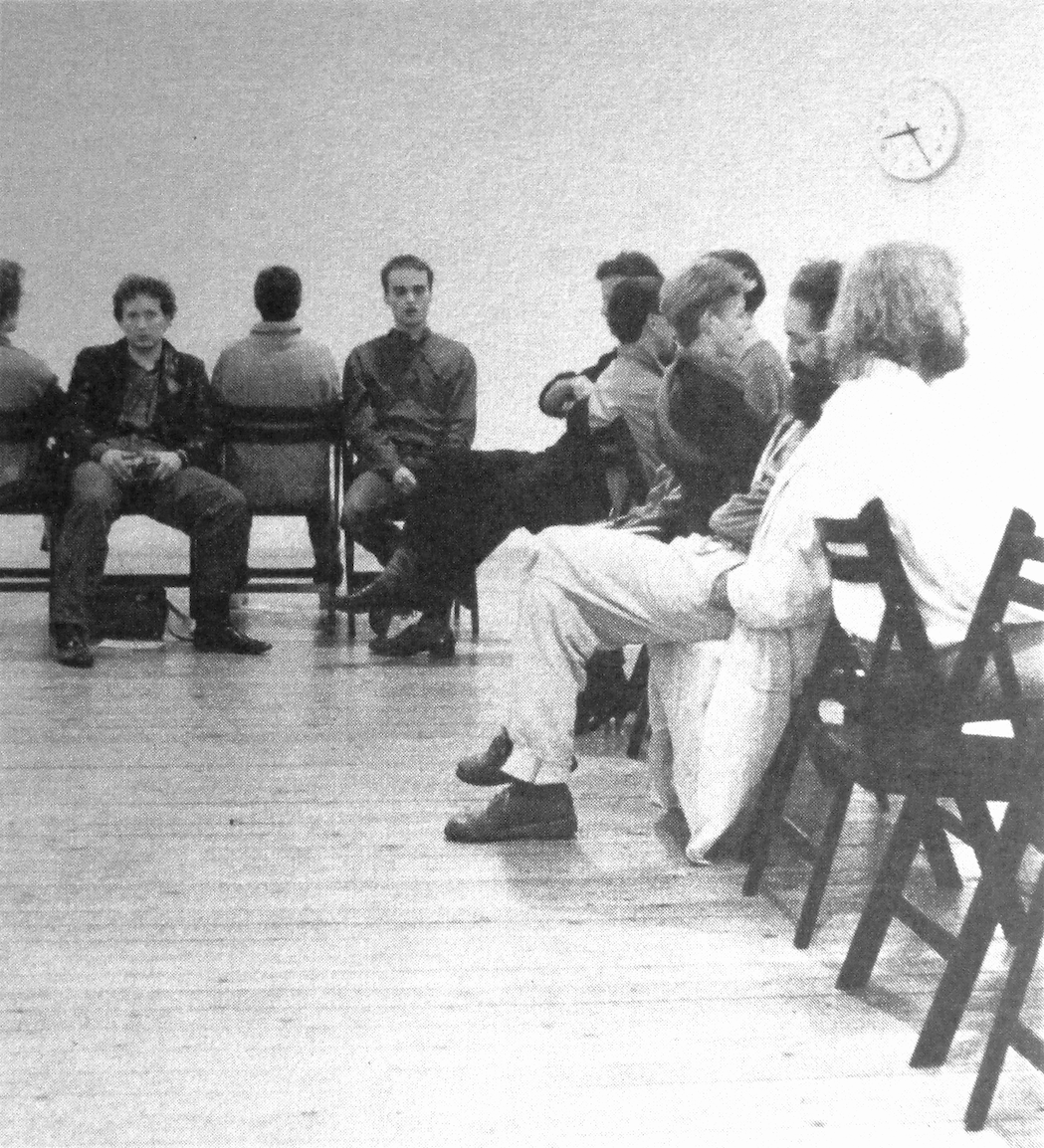Performances
by
Toine Horvers
My work involves movement: hence, it also entails space and time, changes, life, history.
I perceive an overwhelming beauty in processes of movement and change. We only have to take a simple change like light into darkness. It displays such an amazing amount of spatial, physical and psychological aspects that it may be likened to a journey from one world into another.
I'm particularly fascinated by the intangibility of all the subtle movements lying in be tween these extremes.
In the case of theater, music and dance, these kinds of changes and movements are mostly used as means towards narrating a story. Although they constitute the actual story in my work, they are in fact metaphors of life itself.
Initially my work focused on the movements of my own body; transformations that are subject to a stringent formal and temporal process and that gradually tauten my relaxed body.
The sensation of such a movement is that of an adventurous physical and mental journey through time.
A composition of this sort — lasting but several minutes — consists of only two elements: body outline and strength, change and time.
The nature of this process causes me to concentrate on these elements alone, or carrying it even further, forces me to concentrate on these elements. I feel that, as a result, it creates an aura and I strive towards compressing the elements I wish to deal with into a sculpture of concentration.
It is in fact this quest for perfection that, to my mind, is the quintessence of every work of art. The searching acts as a kind of leitmotif throughout my work: each element should contribute as much as possible to the concept, in an eternal attempt to capture the impalpable.
It is a constant battle with the composition's elements. Every new composition requires one to redefine the subject and determine the existential and non-existential factors.
I also touch upon the traditional forms of expression of past centuries: rituals, theater, architecture, dance, vocals, drums, music.
At the same time I long to establish contact with these traditions; history plays a major role in every composition.
These initial body changes occasioned a greater involvement with space, both on an architectural and on a cosmic level.
My body (physical strength) functions as a central motor for a spatial and temporal movement.
The compositions become encounters between human and other sources of energy: light, clouds, waves, the wind.
In a further stage I no longer consider it essential that I myself am actually performing the composition, and I invite other people to participate in the composition.
What remains is pure form, both in space and in time, whereby I act as a designer and organizer.
However, by making the composition dependent on other people, it grows more vulnerable, unstable, but also livelier.
To me, it is precisely this instability and vivaciousness that create the movement's monumentality.
In the end, the quest for space and freedom is what matters most, even if the shape is strict and symmetrical.
"Clouds" and "waves" are about the only words that are available to me as titles for my pieces. But don't they also describe unstable and poetic occurrences?
This dichotomy is perhaps a part of the Dutch tradition of art: land of the sea, clouds, rains, whilst at the same time being so small and orderly in symmetrical and rhythmic lines and spaces (I'm referring to Mondrian).
TRANSFORMATIONS
Starting from an upright, relaxed position, I add a simple alteration to of my physical posture, until I've attained a state of extreme tension.
Afterwards, the shape and tension diminish until the initial position is resumed.
I approach the completion of the entire process as slowly as possible and with the utmost degree of concentration.
T W I L I G H T
Movement sound sculpture
Temple Bar Studios Dublin Ireland 29/5/86.
Performed by 25 volunteer participants.
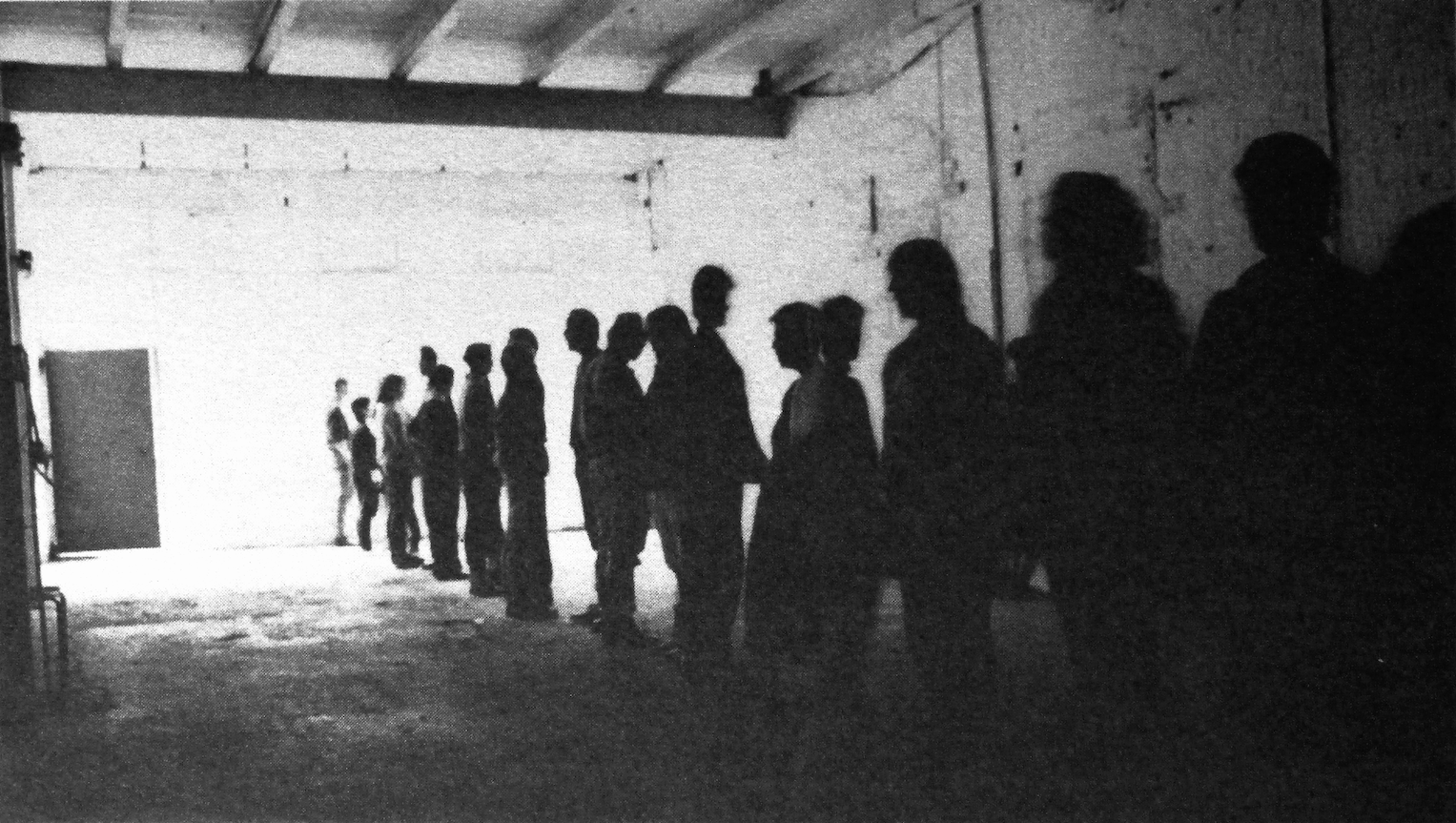
photo: Christine Bond
The new hall-space of the Temple Bar Studios has one short side (which is almost entirely made of glass) that faces onto the street.
Because these are the only windows in the 20 meter long hall, the effect of the daylight is progressively diminished the further into the space one walks. I measured the course of daylight during the twilight hours with a light meter.
Before this piece I conducted a workshop with the participants.
PERFORMANCE:
At 9 pm, when there was still some trace of daylight left, 25 people stood along the space's central line, (in other words): from the light to the dark side.
They stood side by side, alternately looking in opposite directions and making low relaxed vocal sounds.
The volume of those standing in the light part was quite loud while those in the darker area were quieter.
The people in between tried to pitch their voices at a volume relative to their position in the line.
Every four minutes, the person nearest to the window (who was holding a small clock) would take a sideways step towards the dark part and accordingly lower the volume of his or her voice.
The other people would also move up and, in turn, adjust their volume to the new situation.
The person next to the dark wall would then leave the row.
As the daylight diminished, the row became shorter and the total volume of voices decreased.
The work ended after about two hours when the last person who was standing at the end of the row in the dark and working at a very low vocal volume, left the row.
POSTSCRIPT:
During the whole process, the door onto the street was left open so that anyone interested could walk in and out. This meant that as the sound of the voices became weaker, all kinds of elements from the street, such as the voices of passers-by and the lights and sounds or cars, gradually took over the space.
S T I M M E N
Movement Soundsculpture.
Moltkerei Werkstatt Cologne 17/9/86.
Performed by visitors
I wanted to make a sound-wave of voices that would travel through the space and where the course and duration would be defined by the order and time span in which the visitors (who had been requested to participate) entered and remained in the space.
SITUATION AND PERFORMANCE:
Chairs were placed in a row along the central line of the L-shaped space, each facing in a direction opposite to the one next to it.
There was large clock in the corner
It was announced that the work would begin at 8 pm.
On arrival, each visitor was presented with the following text:
You are requested to participate in this voice sculpture for 30 minutes.
Please wait until you've taken to your place.
Sit down and make long, relaxed vocal sounds.
You should make your volume a little lower than the person next to you.
You can define the pitch and the length of the pauses yourself but do it so that you can continue steadily for half an hour.
Try to keep the sound at the same volume as best as possible for 30 minutes.
If each participant stops after half an hour and leaves the row, the sculpture will finish when the last two arrivals, who will make low soft tones, leave the row.
POSTSCRIPT:
Fourteen people participated in the sculpture (almost all the people who visited the performance).
The last people began at 8:30 pm so that the whole process lasted an hour.
Hence, the sound not only became softer, but travelled from the closest points on the L-shape to the furthest; the last two performers couldn't see each other.
B A L A N C E 5
Installation of Motion
Amstelpark Triennal for Sculpture 1984.
12/5, 1 and 16/6, 14/7/84. Amstelpark Amsterdam
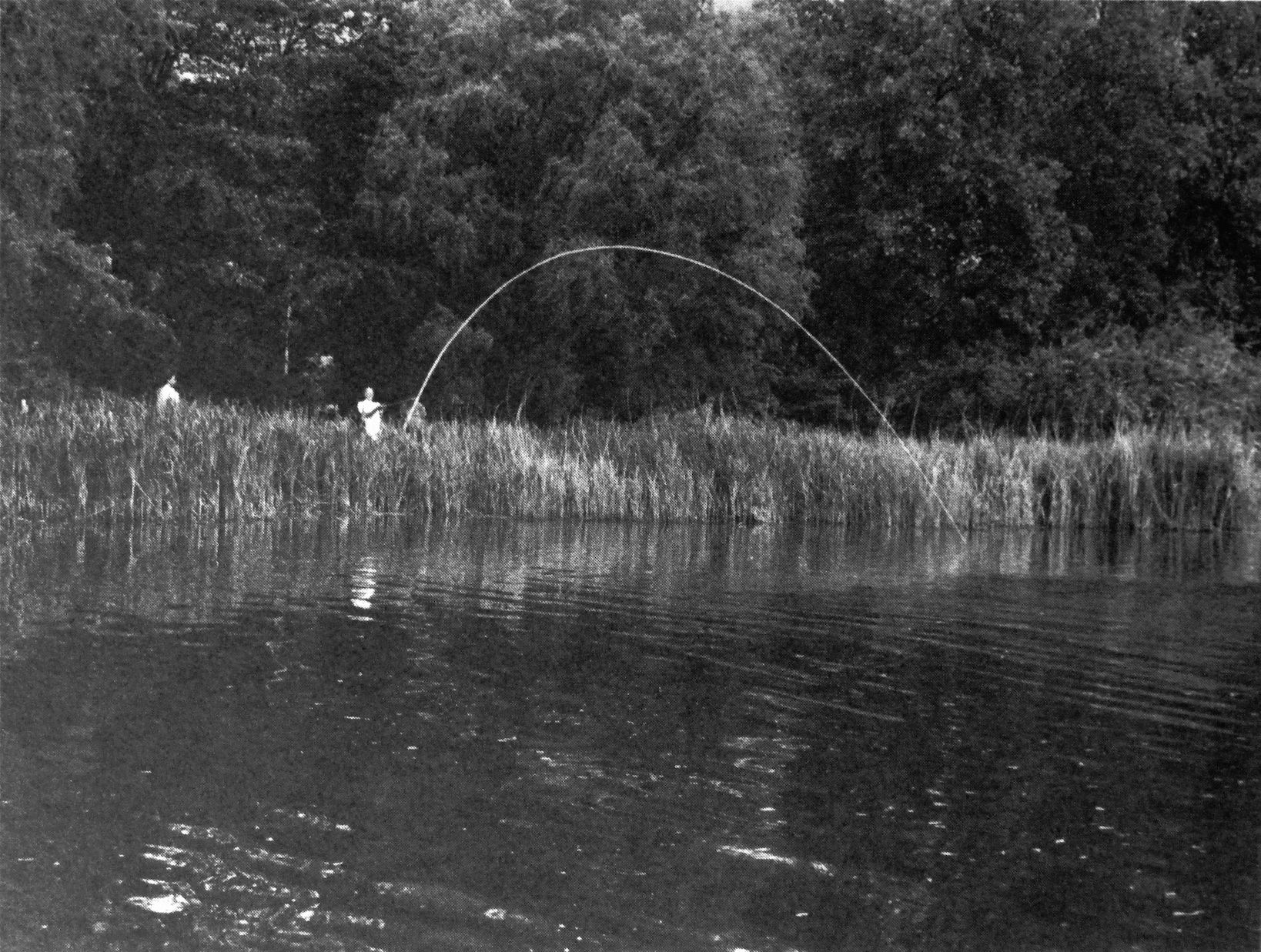
photo: Henk Geraedts
Out of parts of bamboo I have composed a rod of about eighteen meters in length, going from thick (5 cm) to thin (0.3 cm). The rod is painted white.
For during the period of the exhibition I chose four dates on which to show my installation of motion, "Balance 5."
On those days, from 10 am to 6 pm near the edge of the park pond, I balanced the rod for short intervals. During those performances I dress in white. I chose a quiet place in a reeds near the Japanese garden.
I put one end of the rod on a wooden pier and extend the other over the water.
Around my back, and under my armpits, I have a belt with a rope attached, the end of which is connected the rod.
By moving this rope up and down the rod, I can find the position which brings the weight of the rod and mine in balance. I adjust the balance in such a way that I can lean backwards with my body at full stretch, my feet against the foot of the rod and the thin end of the rod resting above the surface of the water, as still as possible, and thus, making it possible to read off when it is out of balance.
Because of the physical inability to stand absolutely still, the length and flexibility of the material used, and the influence of the wind, there is a continuous motion.
Again and again I'm busy making small corrections in the balance.
V A G U E S
Movement Sound Installation
La Genie de la Bastille Passage Rue de la Roquette
Paris France,29/10/88
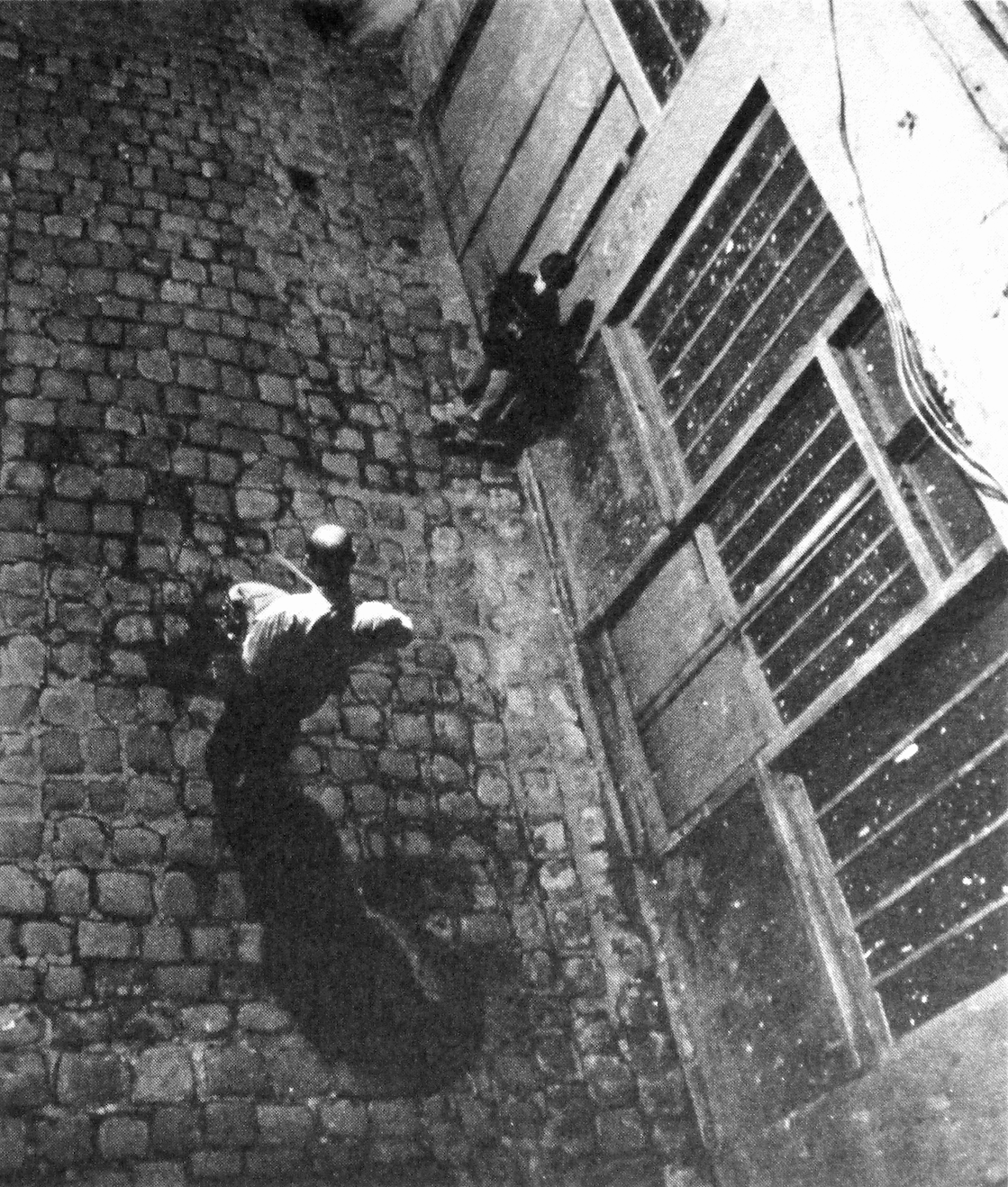
photo: Tracey Mead
SITUATION AND PERFORMANCE:
For one hour I walked up and down the deadend alleyway beating the unbroken drumroll.
My gradual shifts in walking tempo and volume of drumming were directed at making audible and visible waves of human energy that floated along the entire length of the alleyway.
W R I T I N G 1
Movement Sculpture
Lokaal 01 Breda 11 18/9/87
Performed by visitors.
SITUATION AND PLAN:
The two most striking landmarks of the Lokaal 01 space are its pillars. They form twin centers; the surrounding volumes of space are almost equal.
My plan was to translate, as it were, the spatial emanation of those pillars into human energy.
To make the assembled energy — both physical and mental — of a number of people readable by means of writing on the floor.
For eight days those interested could contribute to this writing sculpture.
SET-UP AND ORGANIZATION:
Starting from the centers — the pillars — concentric circles are drawn on the floor that covers almost the entire surface. The distances between are ten centimeters.
The two sets of circles partially overlap one another.
THE NEXT INSTRUCTIONS ARE GIVEN TO THE VISITORS:
Starting on one of the rings, you are invited to keep writing your name in black crayon until you reach the pillar. You have to write on the ring where you start
— whether that is the outermost or one nearer the center — with as little pressure on the crayon as possible.
While continuing to write towards the pillar, this pressure has to be increased as evenly as possible so that in your opinion the blackest and heaviest impression of your name is on the ring closest to the pillar.
You can specify whether you prefer to write a lot (by starting on one of the outer rings) or just a little (by starting on a ring close to the middle.)
SOME IMPORTANT POINTERS:
It is important to write facing towards the middle. This way you can constantly control the ratio between writing pressure and distance.
It is important to write in the space between the lines and preferably as large as possible.
When you come to the end of a ring, you have to go on to the next one, towards the one in the middle.
You have to pay as little attention as possible to those who have been writing before you and try to concentrate on your own writing.
It is important to try not to smudge the crayon with your feet.
W A K E 1
Movement Sculpture
B.K.R. -presentation, Stichting ENNU Tilburg 29/8/84

photo: Henk Geraedts
SITUATION:
Above the middle line of the 21-meters long space of Stichting Ennue, above man's height, I have stretched a nylon thread, with small pieces of paper attached.
At one side are hanging close together and, according to a gradual series, to the distance between them becomes bigger and bigger, from two centimeters till twelve meters. These small pieces of paper are numbered from one to thirty and mark the distances which have to be covered every minute.
PERFORMANCE:
I am at one end of the room, bare-footed, situated so that number one is right above me. I'm dressed in white, carrying a sowing-box filled with white flour. In my left hand I have a digital-clock and behind me, against the wall, there is a metronome marking the seconds.
When the clock has started, I take a handful of flour during the first two seconds and during the third and fourth second I sow it to the right and left as far away as possible. This action is repeated until the end, during 30 minutes. At the same time I move to the next piece of paper, by "dragging" myself forward by my toes.
As the distances grow bigger, the shifting becomes walking with very small steps.
Because the flour is spread over a larger distance per minute, a white path develops, from covering till transparent, with a dark line in the middle marking the movements of my feet.
T U R N I N G 1
The factory, Baarsstraat Eindhoven 11/4/81
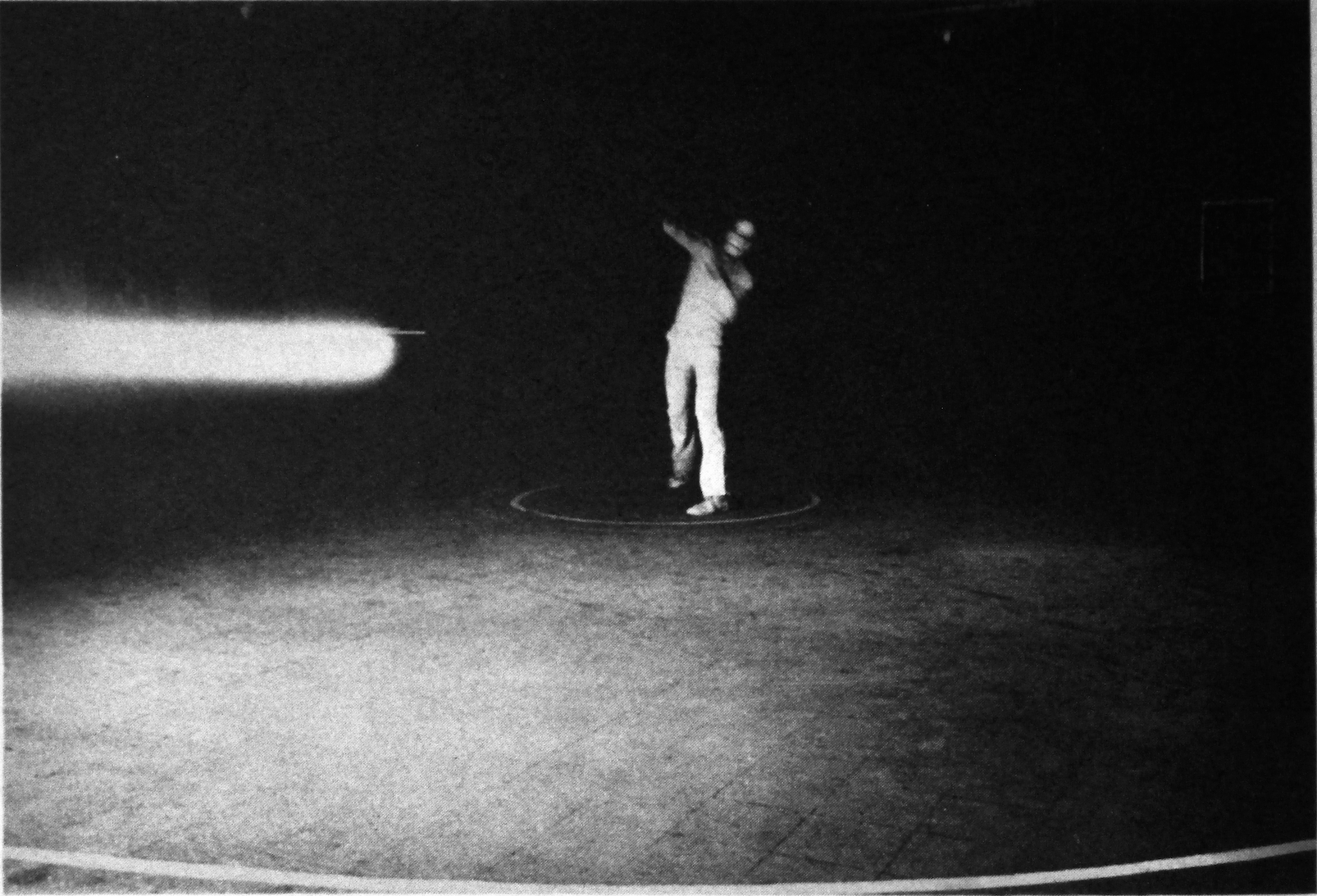
photo: Peter Cox
In the center of the hall I have drawn a circle of one meter with chalk. Around it a circle of ten meter and another one of twelve meters. The audience is requested dressed in white as fast as I can along the circle of ten meters and then go to the center spirally and at the same time reducing speed, until I come to a standstill as close to the lamp as possible. Then I take the lamp, to which a steel cable has been attached, in my hand and make it slowly turn around my head, increasing the speed and the radius of the circle. This increase goes on until the lamp, humming, turns circles with a diameter of 10 to 11 meters at the highest possible speed.

